Analysis of Downer Edi Ltd's Financial Reporting and Accounting Issues
VerifiedAdded on 2023/06/13
|12
|2027
|357
Report
AI Summary
This assignment provides a detailed analysis of Downer Edi Ltd's financial reporting practices, examining its adherence to the General Purpose Financial Reporting framework. It assesses whether the company complies with relevant accounting standards and policies, focusing on the presentation of financial information to stakeholders. The report identifies and discusses the fundamental and enhancing qualitative characteristics evident in Downer Edi Ltd's financial statements, such as relevance, faithful representation, comparability, and verifiability. By evaluating the company's financial reports, including the statement of profit and loss, balance sheet, and cash flow statement, the analysis offers insights into the company's financial performance, resource management, and compliance with accounting standards. Desklib provides access to this and many other solved assignments for students.
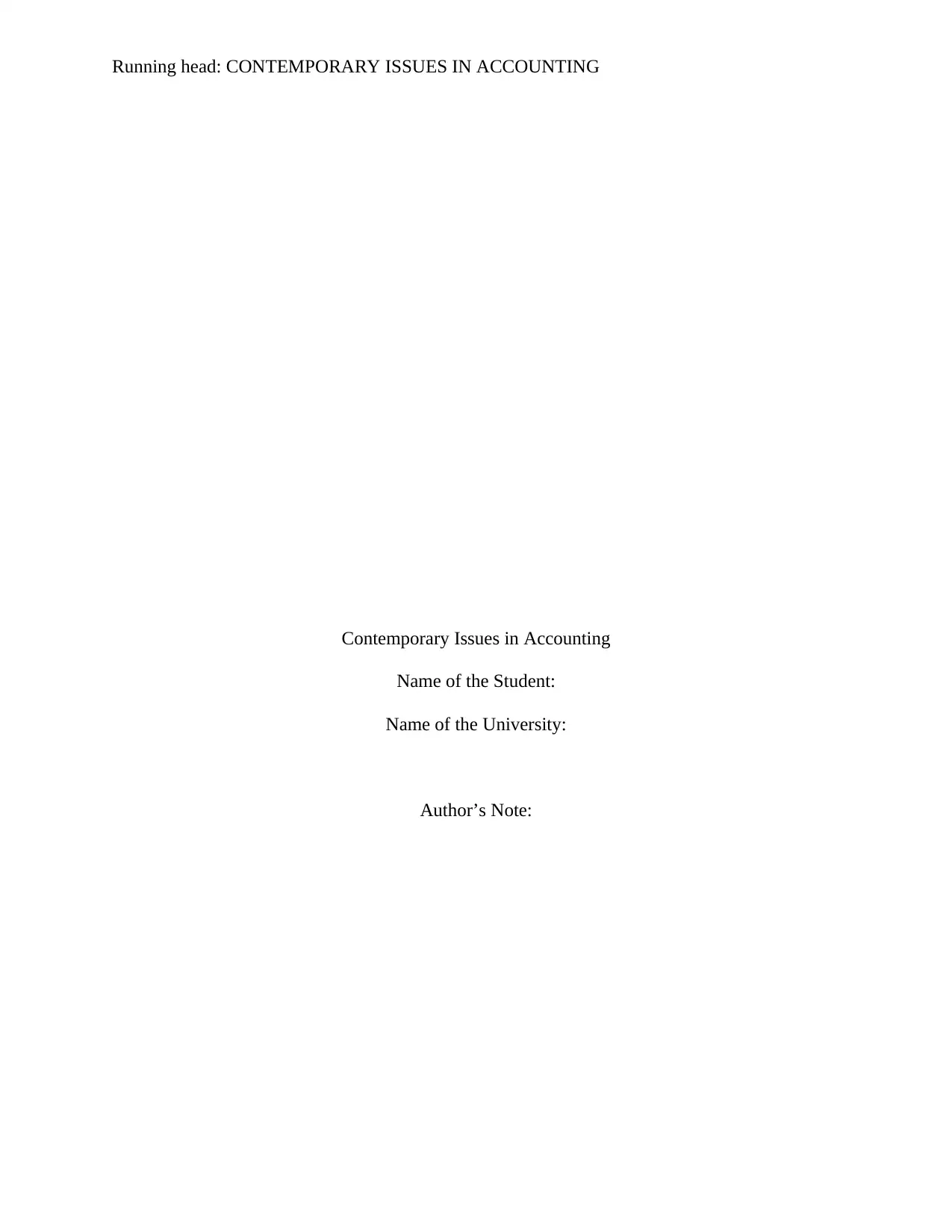
Running head: CONTEMPORARY ISSUES IN ACCOUNTING
Contemporary Issues in Accounting
Name of the Student:
Name of the University:
Author’s Note:
Contemporary Issues in Accounting
Name of the Student:
Name of the University:
Author’s Note:
Paraphrase This Document
Need a fresh take? Get an instant paraphrase of this document with our AI Paraphraser
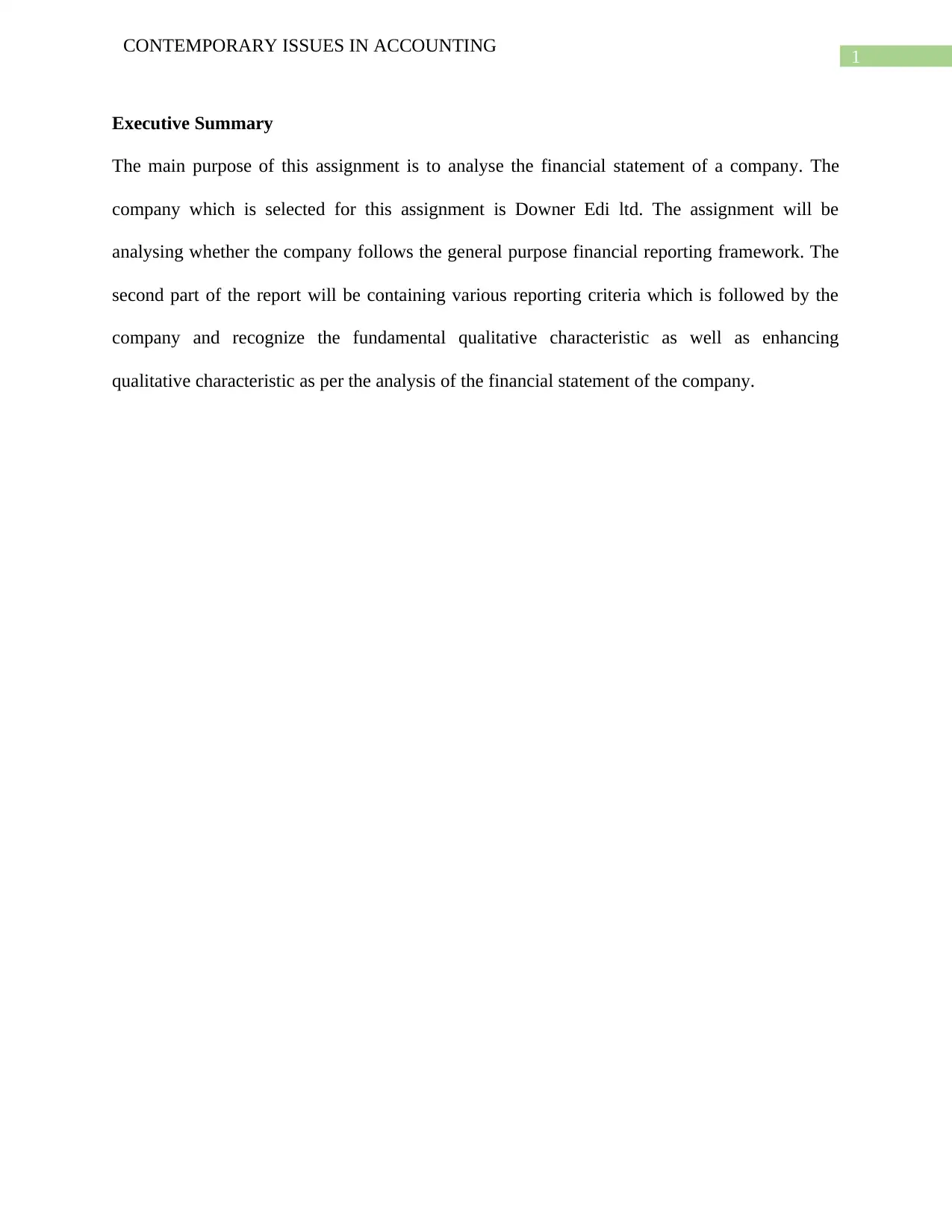
1
CONTEMPORARY ISSUES IN ACCOUNTING
Executive Summary
The main purpose of this assignment is to analyse the financial statement of a company. The
company which is selected for this assignment is Downer Edi ltd. The assignment will be
analysing whether the company follows the general purpose financial reporting framework. The
second part of the report will be containing various reporting criteria which is followed by the
company and recognize the fundamental qualitative characteristic as well as enhancing
qualitative characteristic as per the analysis of the financial statement of the company.
CONTEMPORARY ISSUES IN ACCOUNTING
Executive Summary
The main purpose of this assignment is to analyse the financial statement of a company. The
company which is selected for this assignment is Downer Edi ltd. The assignment will be
analysing whether the company follows the general purpose financial reporting framework. The
second part of the report will be containing various reporting criteria which is followed by the
company and recognize the fundamental qualitative characteristic as well as enhancing
qualitative characteristic as per the analysis of the financial statement of the company.
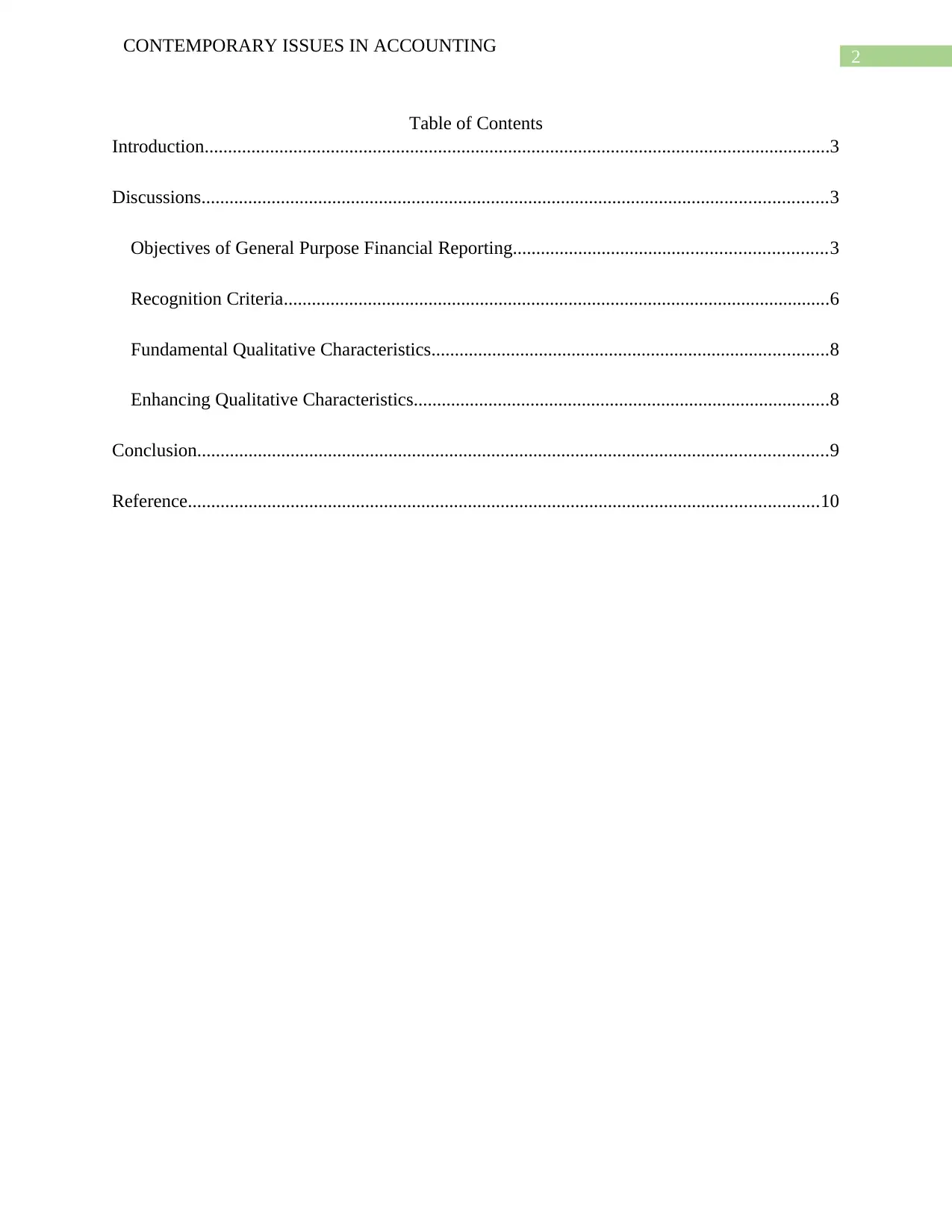
2
CONTEMPORARY ISSUES IN ACCOUNTING
Table of Contents
Introduction......................................................................................................................................3
Discussions......................................................................................................................................3
Objectives of General Purpose Financial Reporting...................................................................3
Recognition Criteria.....................................................................................................................6
Fundamental Qualitative Characteristics.....................................................................................8
Enhancing Qualitative Characteristics.........................................................................................8
Conclusion.......................................................................................................................................9
Reference.......................................................................................................................................10
CONTEMPORARY ISSUES IN ACCOUNTING
Table of Contents
Introduction......................................................................................................................................3
Discussions......................................................................................................................................3
Objectives of General Purpose Financial Reporting...................................................................3
Recognition Criteria.....................................................................................................................6
Fundamental Qualitative Characteristics.....................................................................................8
Enhancing Qualitative Characteristics.........................................................................................8
Conclusion.......................................................................................................................................9
Reference.......................................................................................................................................10
⊘ This is a preview!⊘
Do you want full access?
Subscribe today to unlock all pages.

Trusted by 1+ million students worldwide
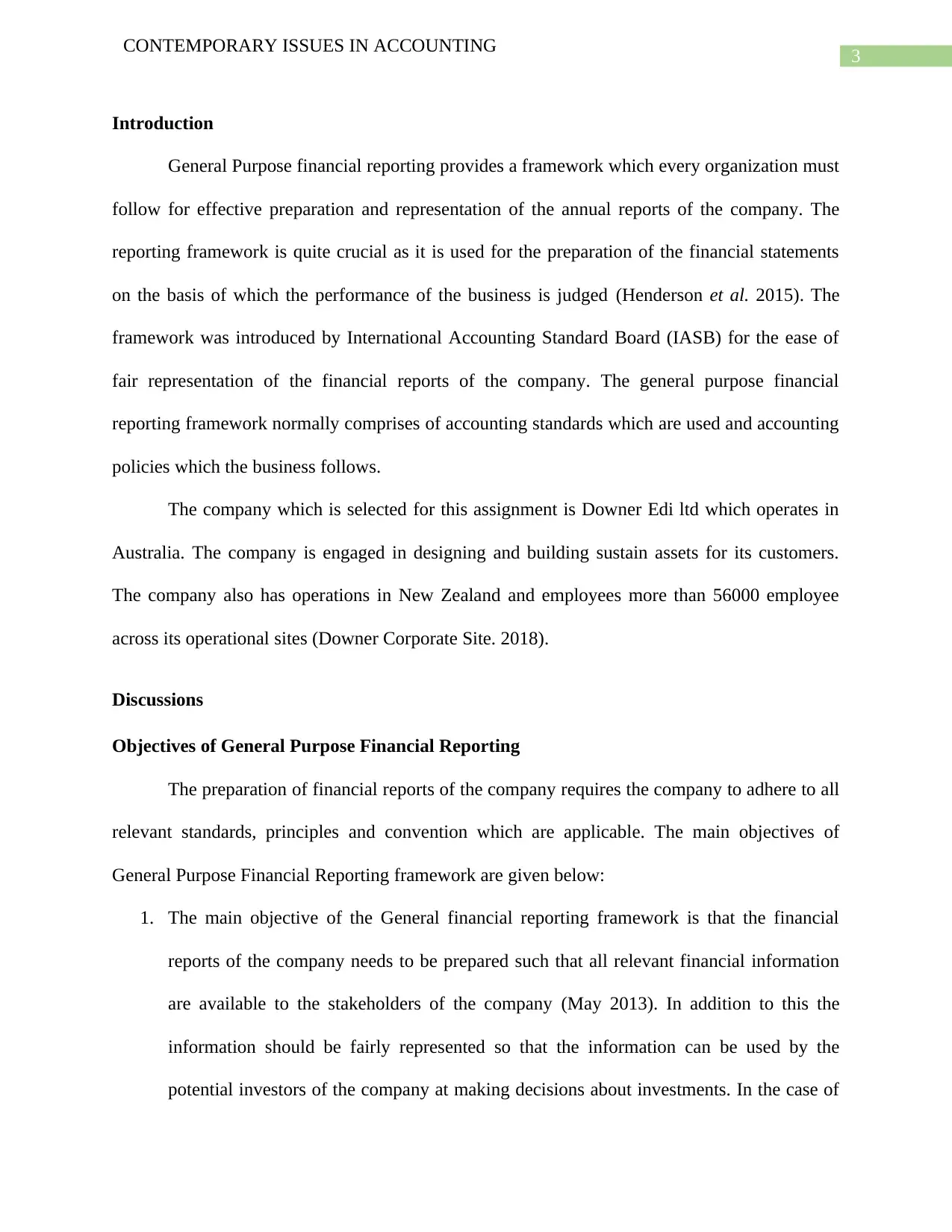
3
CONTEMPORARY ISSUES IN ACCOUNTING
Introduction
General Purpose financial reporting provides a framework which every organization must
follow for effective preparation and representation of the annual reports of the company. The
reporting framework is quite crucial as it is used for the preparation of the financial statements
on the basis of which the performance of the business is judged (Henderson et al. 2015). The
framework was introduced by International Accounting Standard Board (IASB) for the ease of
fair representation of the financial reports of the company. The general purpose financial
reporting framework normally comprises of accounting standards which are used and accounting
policies which the business follows.
The company which is selected for this assignment is Downer Edi ltd which operates in
Australia. The company is engaged in designing and building sustain assets for its customers.
The company also has operations in New Zealand and employees more than 56000 employee
across its operational sites (Downer Corporate Site. 2018).
Discussions
Objectives of General Purpose Financial Reporting
The preparation of financial reports of the company requires the company to adhere to all
relevant standards, principles and convention which are applicable. The main objectives of
General Purpose Financial Reporting framework are given below:
1. The main objective of the General financial reporting framework is that the financial
reports of the company needs to be prepared such that all relevant financial information
are available to the stakeholders of the company (May 2013). In addition to this the
information should be fairly represented so that the information can be used by the
potential investors of the company at making decisions about investments. In the case of
CONTEMPORARY ISSUES IN ACCOUNTING
Introduction
General Purpose financial reporting provides a framework which every organization must
follow for effective preparation and representation of the annual reports of the company. The
reporting framework is quite crucial as it is used for the preparation of the financial statements
on the basis of which the performance of the business is judged (Henderson et al. 2015). The
framework was introduced by International Accounting Standard Board (IASB) for the ease of
fair representation of the financial reports of the company. The general purpose financial
reporting framework normally comprises of accounting standards which are used and accounting
policies which the business follows.
The company which is selected for this assignment is Downer Edi ltd which operates in
Australia. The company is engaged in designing and building sustain assets for its customers.
The company also has operations in New Zealand and employees more than 56000 employee
across its operational sites (Downer Corporate Site. 2018).
Discussions
Objectives of General Purpose Financial Reporting
The preparation of financial reports of the company requires the company to adhere to all
relevant standards, principles and convention which are applicable. The main objectives of
General Purpose Financial Reporting framework are given below:
1. The main objective of the General financial reporting framework is that the financial
reports of the company needs to be prepared such that all relevant financial information
are available to the stakeholders of the company (May 2013). In addition to this the
information should be fairly represented so that the information can be used by the
potential investors of the company at making decisions about investments. In the case of
Paraphrase This Document
Need a fresh take? Get an instant paraphrase of this document with our AI Paraphraser
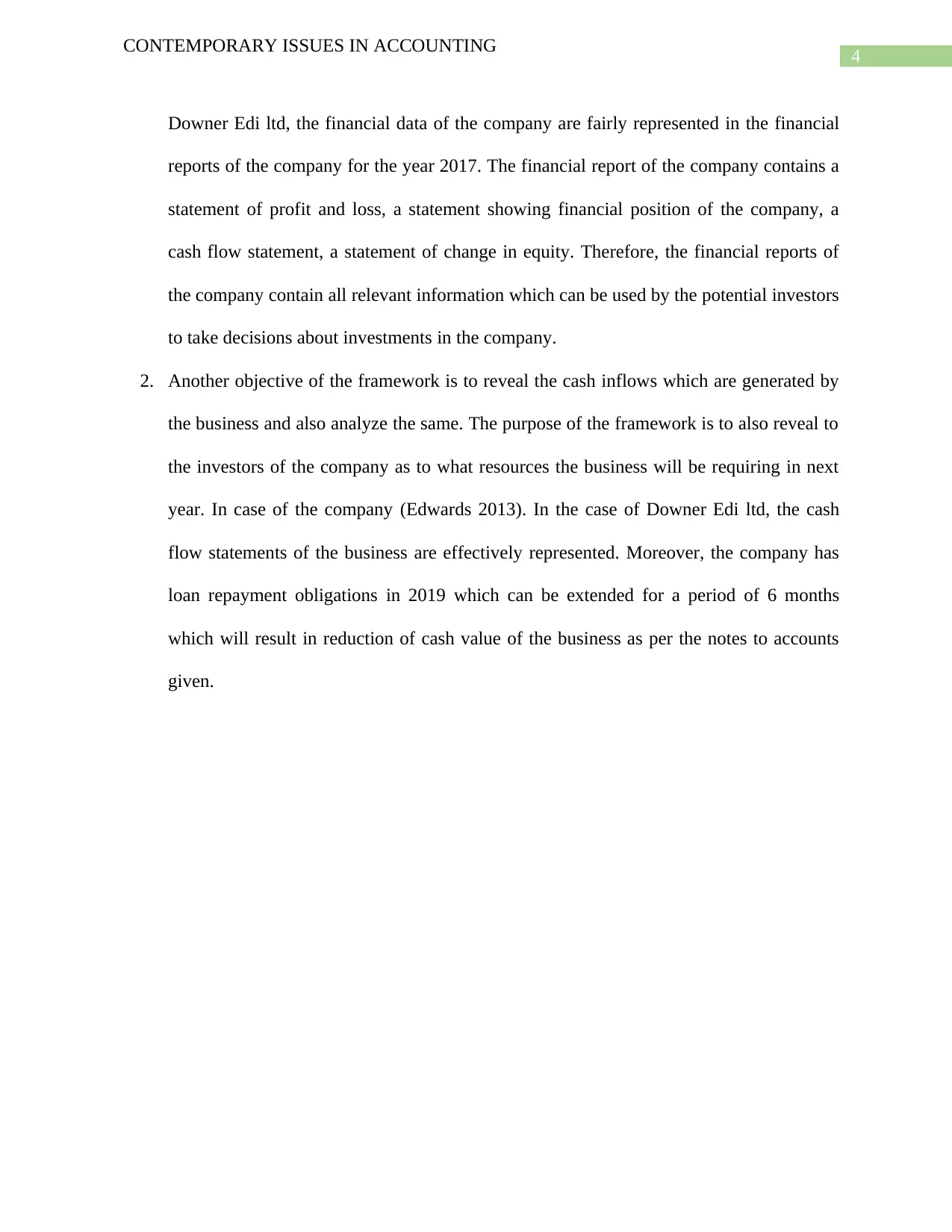
4
CONTEMPORARY ISSUES IN ACCOUNTING
Downer Edi ltd, the financial data of the company are fairly represented in the financial
reports of the company for the year 2017. The financial report of the company contains a
statement of profit and loss, a statement showing financial position of the company, a
cash flow statement, a statement of change in equity. Therefore, the financial reports of
the company contain all relevant information which can be used by the potential investors
to take decisions about investments in the company.
2. Another objective of the framework is to reveal the cash inflows which are generated by
the business and also analyze the same. The purpose of the framework is to also reveal to
the investors of the company as to what resources the business will be requiring in next
year. In case of the company (Edwards 2013). In the case of Downer Edi ltd, the cash
flow statements of the business are effectively represented. Moreover, the company has
loan repayment obligations in 2019 which can be extended for a period of 6 months
which will result in reduction of cash value of the business as per the notes to accounts
given.
CONTEMPORARY ISSUES IN ACCOUNTING
Downer Edi ltd, the financial data of the company are fairly represented in the financial
reports of the company for the year 2017. The financial report of the company contains a
statement of profit and loss, a statement showing financial position of the company, a
cash flow statement, a statement of change in equity. Therefore, the financial reports of
the company contain all relevant information which can be used by the potential investors
to take decisions about investments in the company.
2. Another objective of the framework is to reveal the cash inflows which are generated by
the business and also analyze the same. The purpose of the framework is to also reveal to
the investors of the company as to what resources the business will be requiring in next
year. In case of the company (Edwards 2013). In the case of Downer Edi ltd, the cash
flow statements of the business are effectively represented. Moreover, the company has
loan repayment obligations in 2019 which can be extended for a period of 6 months
which will result in reduction of cash value of the business as per the notes to accounts
given.
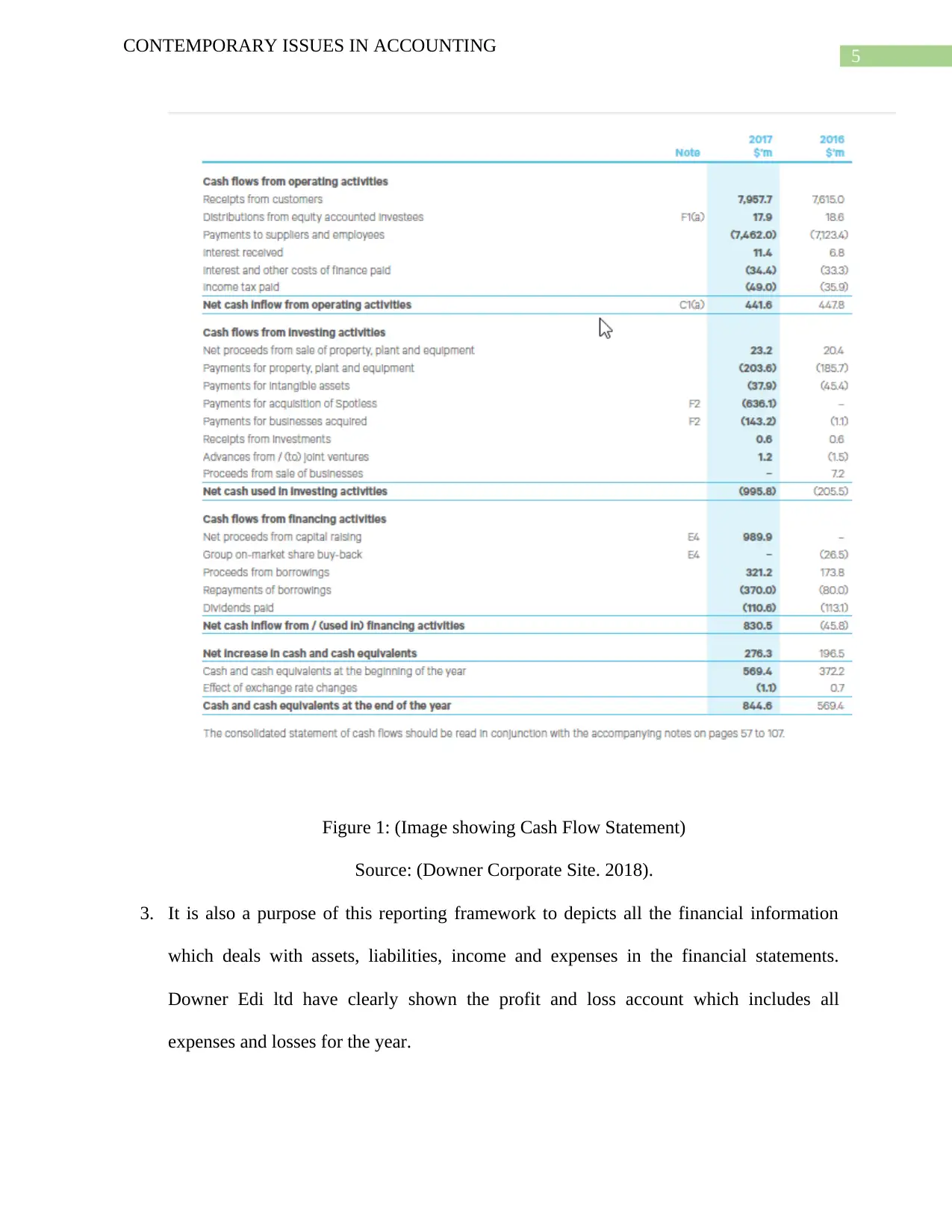
5
CONTEMPORARY ISSUES IN ACCOUNTING
Figure 1: (Image showing Cash Flow Statement)
Source: (Downer Corporate Site. 2018).
3. It is also a purpose of this reporting framework to depicts all the financial information
which deals with assets, liabilities, income and expenses in the financial statements.
Downer Edi ltd have clearly shown the profit and loss account which includes all
expenses and losses for the year.
CONTEMPORARY ISSUES IN ACCOUNTING
Figure 1: (Image showing Cash Flow Statement)
Source: (Downer Corporate Site. 2018).
3. It is also a purpose of this reporting framework to depicts all the financial information
which deals with assets, liabilities, income and expenses in the financial statements.
Downer Edi ltd have clearly shown the profit and loss account which includes all
expenses and losses for the year.
⊘ This is a preview!⊘
Do you want full access?
Subscribe today to unlock all pages.

Trusted by 1+ million students worldwide
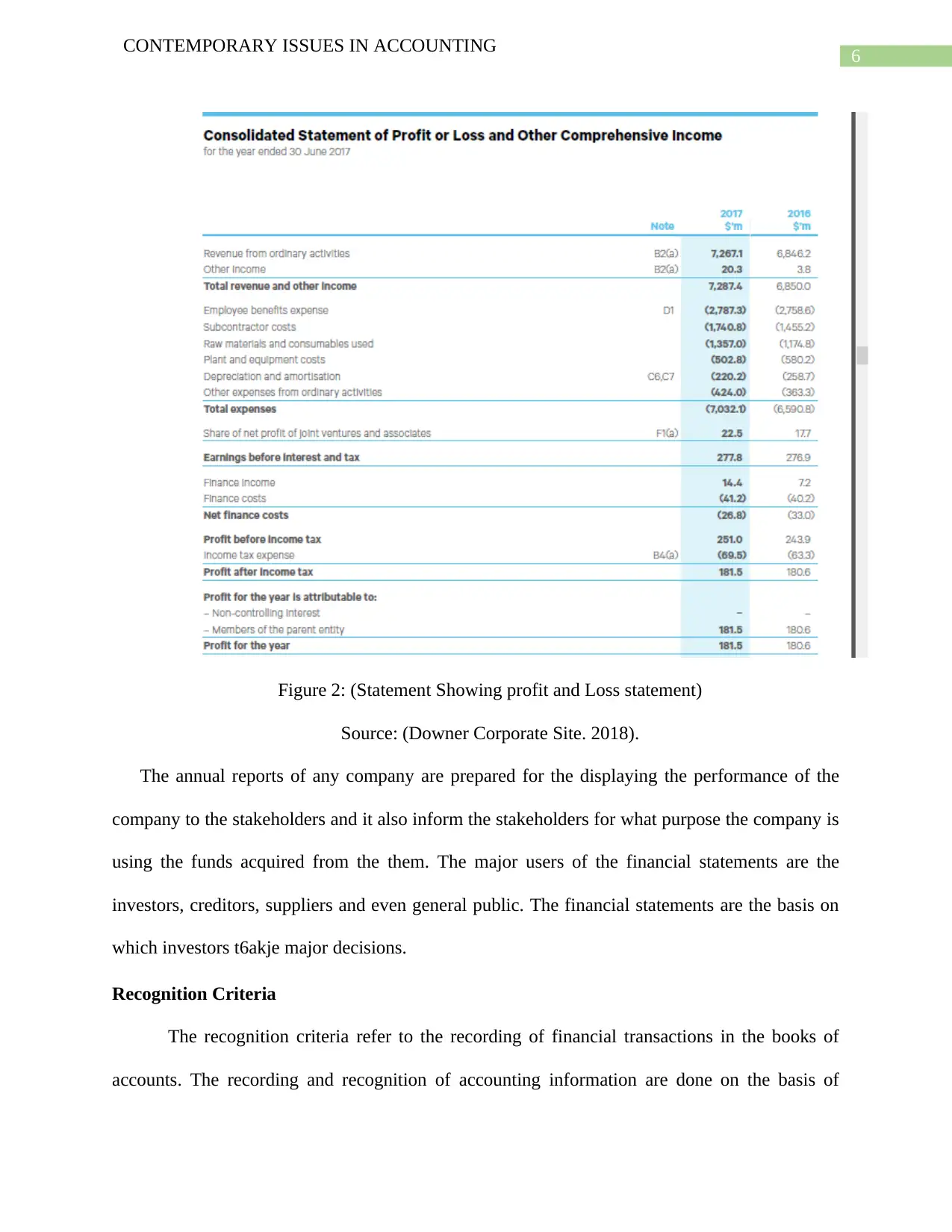
6
CONTEMPORARY ISSUES IN ACCOUNTING
Figure 2: (Statement Showing profit and Loss statement)
Source: (Downer Corporate Site. 2018).
The annual reports of any company are prepared for the displaying the performance of the
company to the stakeholders and it also inform the stakeholders for what purpose the company is
using the funds acquired from the them. The major users of the financial statements are the
investors, creditors, suppliers and even general public. The financial statements are the basis on
which investors t6akje major decisions.
Recognition Criteria
The recognition criteria refer to the recording of financial transactions in the books of
accounts. The recording and recognition of accounting information are done on the basis of
CONTEMPORARY ISSUES IN ACCOUNTING
Figure 2: (Statement Showing profit and Loss statement)
Source: (Downer Corporate Site. 2018).
The annual reports of any company are prepared for the displaying the performance of the
company to the stakeholders and it also inform the stakeholders for what purpose the company is
using the funds acquired from the them. The major users of the financial statements are the
investors, creditors, suppliers and even general public. The financial statements are the basis on
which investors t6akje major decisions.
Recognition Criteria
The recognition criteria refer to the recording of financial transactions in the books of
accounts. The recording and recognition of accounting information are done on the basis of
Paraphrase This Document
Need a fresh take? Get an instant paraphrase of this document with our AI Paraphraser
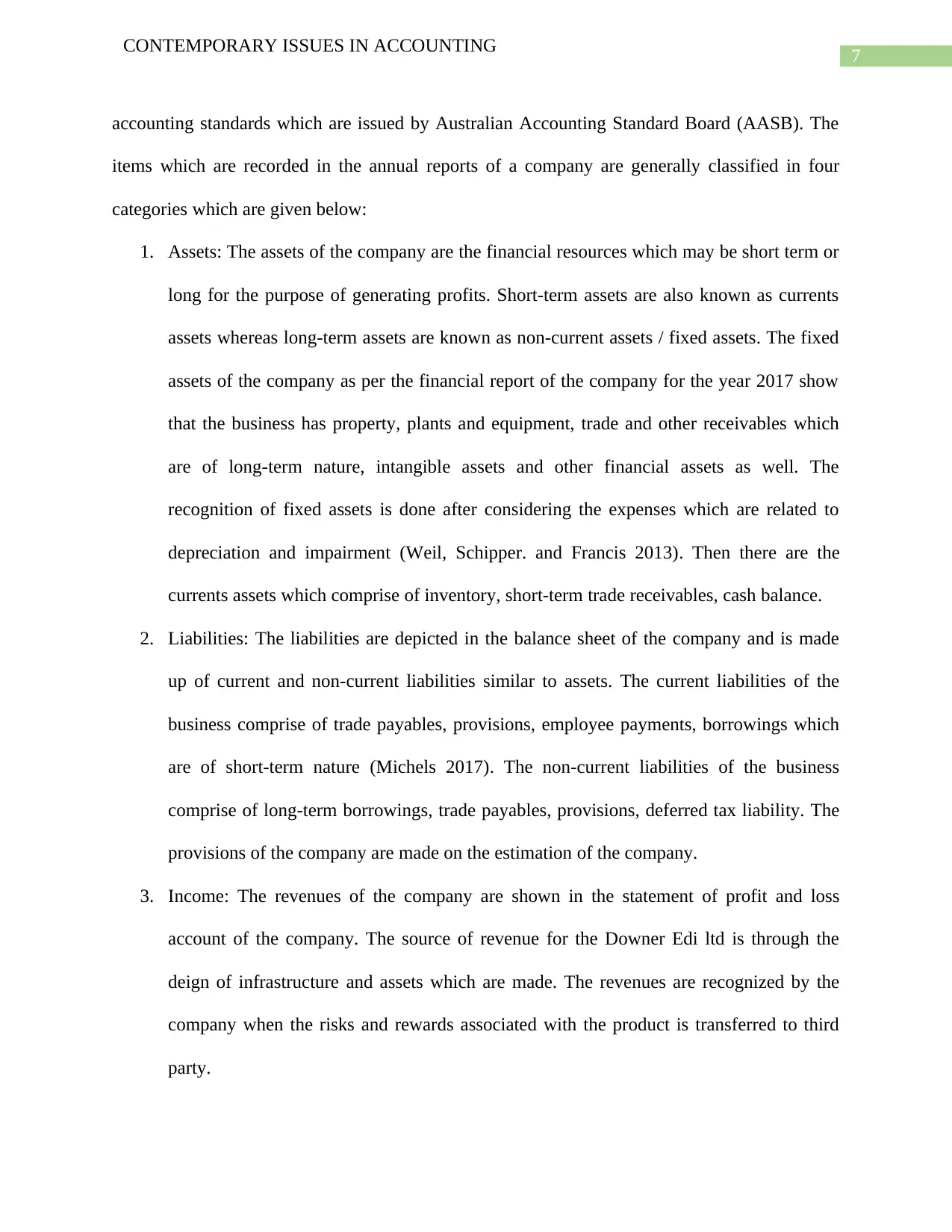
7
CONTEMPORARY ISSUES IN ACCOUNTING
accounting standards which are issued by Australian Accounting Standard Board (AASB). The
items which are recorded in the annual reports of a company are generally classified in four
categories which are given below:
1. Assets: The assets of the company are the financial resources which may be short term or
long for the purpose of generating profits. Short-term assets are also known as currents
assets whereas long-term assets are known as non-current assets / fixed assets. The fixed
assets of the company as per the financial report of the company for the year 2017 show
that the business has property, plants and equipment, trade and other receivables which
are of long-term nature, intangible assets and other financial assets as well. The
recognition of fixed assets is done after considering the expenses which are related to
depreciation and impairment (Weil, Schipper. and Francis 2013). Then there are the
currents assets which comprise of inventory, short-term trade receivables, cash balance.
2. Liabilities: The liabilities are depicted in the balance sheet of the company and is made
up of current and non-current liabilities similar to assets. The current liabilities of the
business comprise of trade payables, provisions, employee payments, borrowings which
are of short-term nature (Michels 2017). The non-current liabilities of the business
comprise of long-term borrowings, trade payables, provisions, deferred tax liability. The
provisions of the company are made on the estimation of the company.
3. Income: The revenues of the company are shown in the statement of profit and loss
account of the company. The source of revenue for the Downer Edi ltd is through the
deign of infrastructure and assets which are made. The revenues are recognized by the
company when the risks and rewards associated with the product is transferred to third
party.
CONTEMPORARY ISSUES IN ACCOUNTING
accounting standards which are issued by Australian Accounting Standard Board (AASB). The
items which are recorded in the annual reports of a company are generally classified in four
categories which are given below:
1. Assets: The assets of the company are the financial resources which may be short term or
long for the purpose of generating profits. Short-term assets are also known as currents
assets whereas long-term assets are known as non-current assets / fixed assets. The fixed
assets of the company as per the financial report of the company for the year 2017 show
that the business has property, plants and equipment, trade and other receivables which
are of long-term nature, intangible assets and other financial assets as well. The
recognition of fixed assets is done after considering the expenses which are related to
depreciation and impairment (Weil, Schipper. and Francis 2013). Then there are the
currents assets which comprise of inventory, short-term trade receivables, cash balance.
2. Liabilities: The liabilities are depicted in the balance sheet of the company and is made
up of current and non-current liabilities similar to assets. The current liabilities of the
business comprise of trade payables, provisions, employee payments, borrowings which
are of short-term nature (Michels 2017). The non-current liabilities of the business
comprise of long-term borrowings, trade payables, provisions, deferred tax liability. The
provisions of the company are made on the estimation of the company.
3. Income: The revenues of the company are shown in the statement of profit and loss
account of the company. The source of revenue for the Downer Edi ltd is through the
deign of infrastructure and assets which are made. The revenues are recognized by the
company when the risks and rewards associated with the product is transferred to third
party.
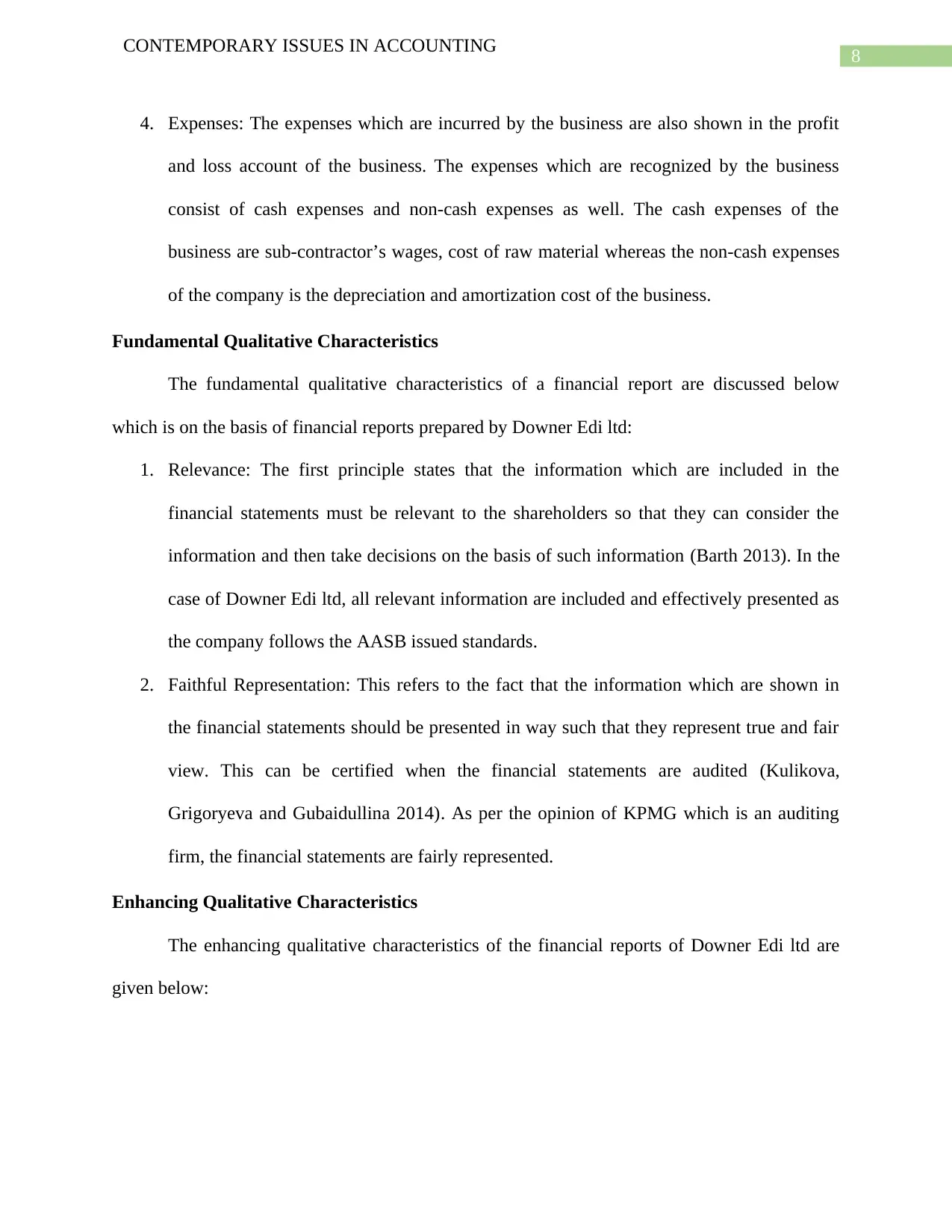
8
CONTEMPORARY ISSUES IN ACCOUNTING
4. Expenses: The expenses which are incurred by the business are also shown in the profit
and loss account of the business. The expenses which are recognized by the business
consist of cash expenses and non-cash expenses as well. The cash expenses of the
business are sub-contractor’s wages, cost of raw material whereas the non-cash expenses
of the company is the depreciation and amortization cost of the business.
Fundamental Qualitative Characteristics
The fundamental qualitative characteristics of a financial report are discussed below
which is on the basis of financial reports prepared by Downer Edi ltd:
1. Relevance: The first principle states that the information which are included in the
financial statements must be relevant to the shareholders so that they can consider the
information and then take decisions on the basis of such information (Barth 2013). In the
case of Downer Edi ltd, all relevant information are included and effectively presented as
the company follows the AASB issued standards.
2. Faithful Representation: This refers to the fact that the information which are shown in
the financial statements should be presented in way such that they represent true and fair
view. This can be certified when the financial statements are audited (Kulikova,
Grigoryeva and Gubaidullina 2014). As per the opinion of KPMG which is an auditing
firm, the financial statements are fairly represented.
Enhancing Qualitative Characteristics
The enhancing qualitative characteristics of the financial reports of Downer Edi ltd are
given below:
CONTEMPORARY ISSUES IN ACCOUNTING
4. Expenses: The expenses which are incurred by the business are also shown in the profit
and loss account of the business. The expenses which are recognized by the business
consist of cash expenses and non-cash expenses as well. The cash expenses of the
business are sub-contractor’s wages, cost of raw material whereas the non-cash expenses
of the company is the depreciation and amortization cost of the business.
Fundamental Qualitative Characteristics
The fundamental qualitative characteristics of a financial report are discussed below
which is on the basis of financial reports prepared by Downer Edi ltd:
1. Relevance: The first principle states that the information which are included in the
financial statements must be relevant to the shareholders so that they can consider the
information and then take decisions on the basis of such information (Barth 2013). In the
case of Downer Edi ltd, all relevant information are included and effectively presented as
the company follows the AASB issued standards.
2. Faithful Representation: This refers to the fact that the information which are shown in
the financial statements should be presented in way such that they represent true and fair
view. This can be certified when the financial statements are audited (Kulikova,
Grigoryeva and Gubaidullina 2014). As per the opinion of KPMG which is an auditing
firm, the financial statements are fairly represented.
Enhancing Qualitative Characteristics
The enhancing qualitative characteristics of the financial reports of Downer Edi ltd are
given below:
⊘ This is a preview!⊘
Do you want full access?
Subscribe today to unlock all pages.

Trusted by 1+ million students worldwide
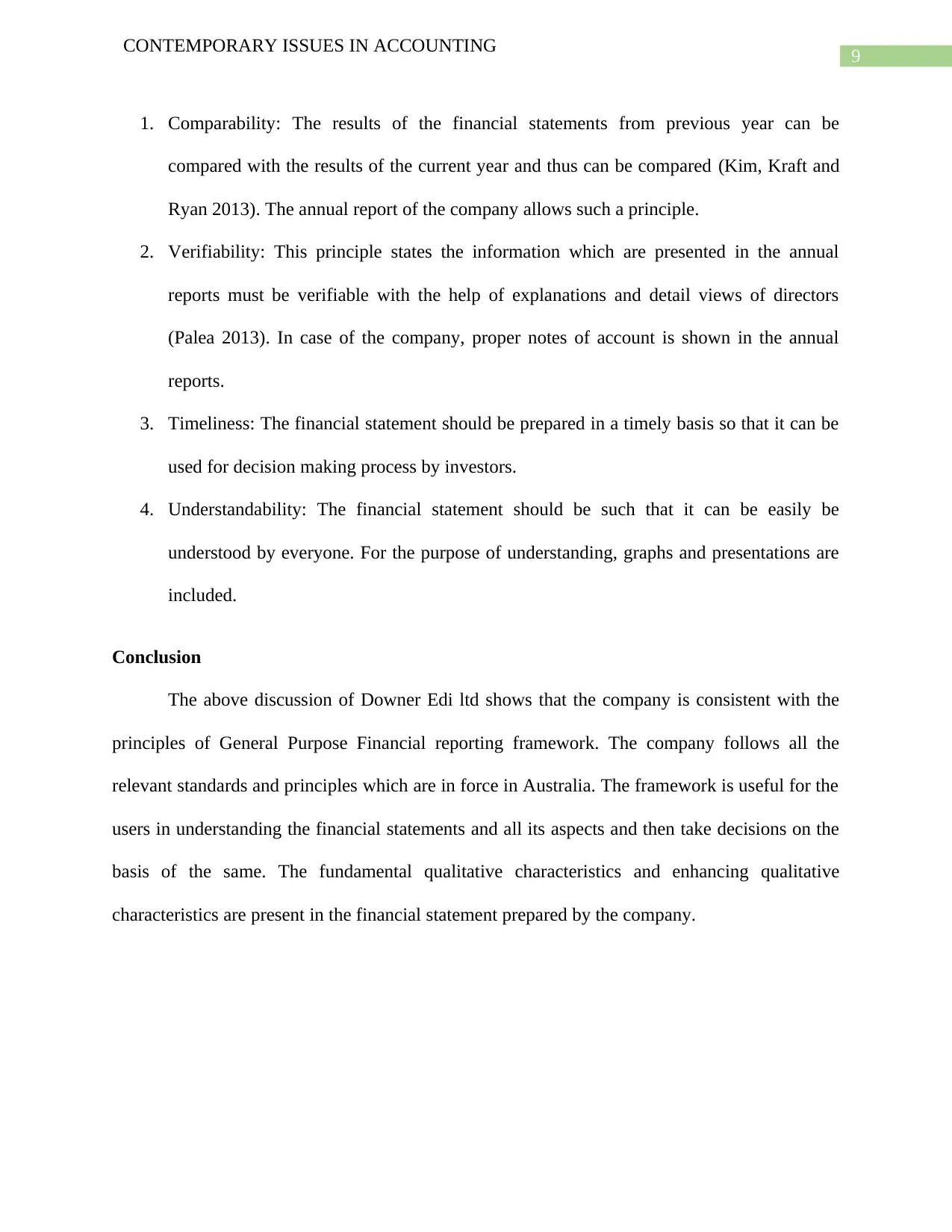
9
CONTEMPORARY ISSUES IN ACCOUNTING
1. Comparability: The results of the financial statements from previous year can be
compared with the results of the current year and thus can be compared (Kim, Kraft and
Ryan 2013). The annual report of the company allows such a principle.
2. Verifiability: This principle states the information which are presented in the annual
reports must be verifiable with the help of explanations and detail views of directors
(Palea 2013). In case of the company, proper notes of account is shown in the annual
reports.
3. Timeliness: The financial statement should be prepared in a timely basis so that it can be
used for decision making process by investors.
4. Understandability: The financial statement should be such that it can be easily be
understood by everyone. For the purpose of understanding, graphs and presentations are
included.
Conclusion
The above discussion of Downer Edi ltd shows that the company is consistent with the
principles of General Purpose Financial reporting framework. The company follows all the
relevant standards and principles which are in force in Australia. The framework is useful for the
users in understanding the financial statements and all its aspects and then take decisions on the
basis of the same. The fundamental qualitative characteristics and enhancing qualitative
characteristics are present in the financial statement prepared by the company.
CONTEMPORARY ISSUES IN ACCOUNTING
1. Comparability: The results of the financial statements from previous year can be
compared with the results of the current year and thus can be compared (Kim, Kraft and
Ryan 2013). The annual report of the company allows such a principle.
2. Verifiability: This principle states the information which are presented in the annual
reports must be verifiable with the help of explanations and detail views of directors
(Palea 2013). In case of the company, proper notes of account is shown in the annual
reports.
3. Timeliness: The financial statement should be prepared in a timely basis so that it can be
used for decision making process by investors.
4. Understandability: The financial statement should be such that it can be easily be
understood by everyone. For the purpose of understanding, graphs and presentations are
included.
Conclusion
The above discussion of Downer Edi ltd shows that the company is consistent with the
principles of General Purpose Financial reporting framework. The company follows all the
relevant standards and principles which are in force in Australia. The framework is useful for the
users in understanding the financial statements and all its aspects and then take decisions on the
basis of the same. The fundamental qualitative characteristics and enhancing qualitative
characteristics are present in the financial statement prepared by the company.
Paraphrase This Document
Need a fresh take? Get an instant paraphrase of this document with our AI Paraphraser
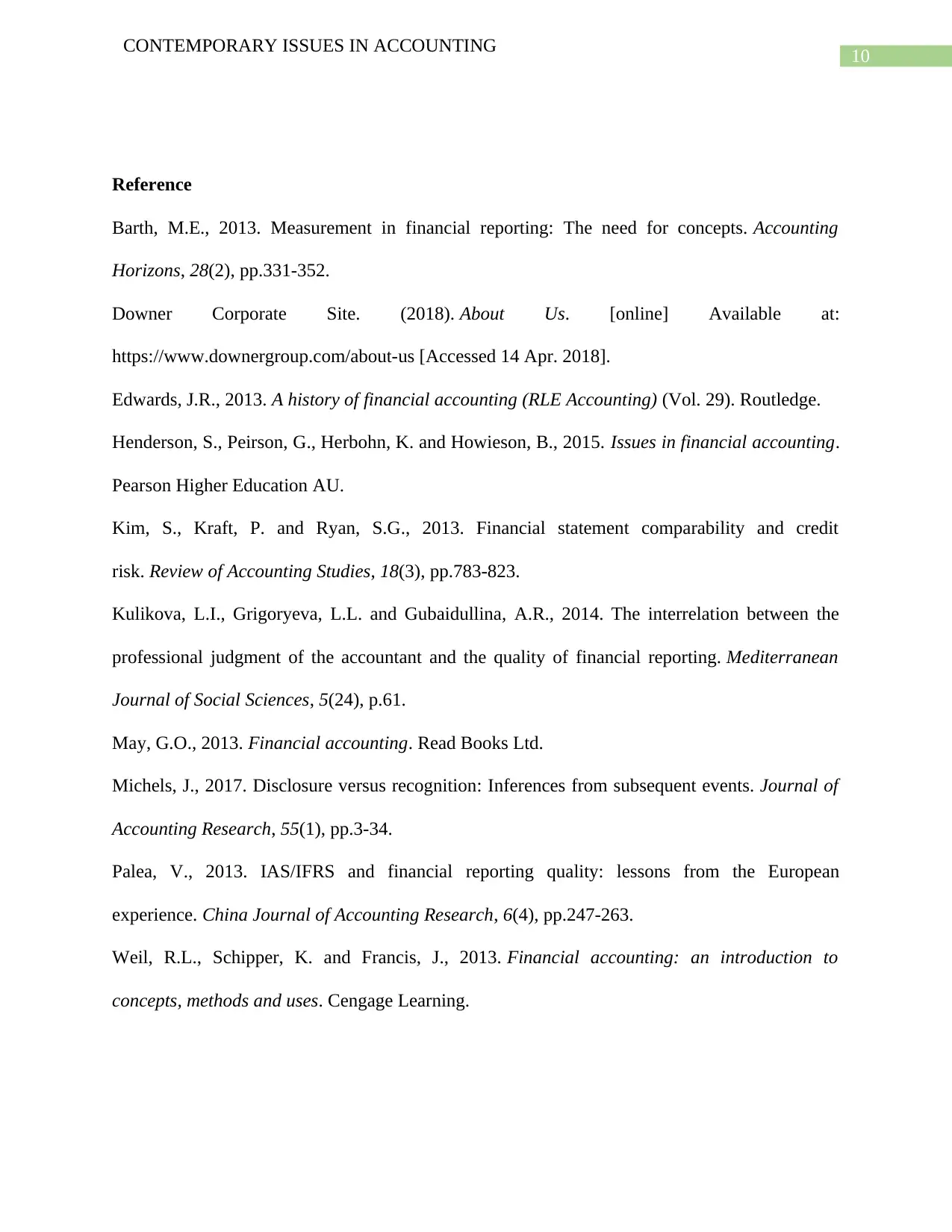
10
CONTEMPORARY ISSUES IN ACCOUNTING
Reference
Barth, M.E., 2013. Measurement in financial reporting: The need for concepts. Accounting
Horizons, 28(2), pp.331-352.
Downer Corporate Site. (2018). About Us. [online] Available at:
https://www.downergroup.com/about-us [Accessed 14 Apr. 2018].
Edwards, J.R., 2013. A history of financial accounting (RLE Accounting) (Vol. 29). Routledge.
Henderson, S., Peirson, G., Herbohn, K. and Howieson, B., 2015. Issues in financial accounting.
Pearson Higher Education AU.
Kim, S., Kraft, P. and Ryan, S.G., 2013. Financial statement comparability and credit
risk. Review of Accounting Studies, 18(3), pp.783-823.
Kulikova, L.I., Grigoryeva, L.L. and Gubaidullina, A.R., 2014. The interrelation between the
professional judgment of the accountant and the quality of financial reporting. Mediterranean
Journal of Social Sciences, 5(24), p.61.
May, G.O., 2013. Financial accounting. Read Books Ltd.
Michels, J., 2017. Disclosure versus recognition: Inferences from subsequent events. Journal of
Accounting Research, 55(1), pp.3-34.
Palea, V., 2013. IAS/IFRS and financial reporting quality: lessons from the European
experience. China Journal of Accounting Research, 6(4), pp.247-263.
Weil, R.L., Schipper, K. and Francis, J., 2013. Financial accounting: an introduction to
concepts, methods and uses. Cengage Learning.
CONTEMPORARY ISSUES IN ACCOUNTING
Reference
Barth, M.E., 2013. Measurement in financial reporting: The need for concepts. Accounting
Horizons, 28(2), pp.331-352.
Downer Corporate Site. (2018). About Us. [online] Available at:
https://www.downergroup.com/about-us [Accessed 14 Apr. 2018].
Edwards, J.R., 2013. A history of financial accounting (RLE Accounting) (Vol. 29). Routledge.
Henderson, S., Peirson, G., Herbohn, K. and Howieson, B., 2015. Issues in financial accounting.
Pearson Higher Education AU.
Kim, S., Kraft, P. and Ryan, S.G., 2013. Financial statement comparability and credit
risk. Review of Accounting Studies, 18(3), pp.783-823.
Kulikova, L.I., Grigoryeva, L.L. and Gubaidullina, A.R., 2014. The interrelation between the
professional judgment of the accountant and the quality of financial reporting. Mediterranean
Journal of Social Sciences, 5(24), p.61.
May, G.O., 2013. Financial accounting. Read Books Ltd.
Michels, J., 2017. Disclosure versus recognition: Inferences from subsequent events. Journal of
Accounting Research, 55(1), pp.3-34.
Palea, V., 2013. IAS/IFRS and financial reporting quality: lessons from the European
experience. China Journal of Accounting Research, 6(4), pp.247-263.
Weil, R.L., Schipper, K. and Francis, J., 2013. Financial accounting: an introduction to
concepts, methods and uses. Cengage Learning.
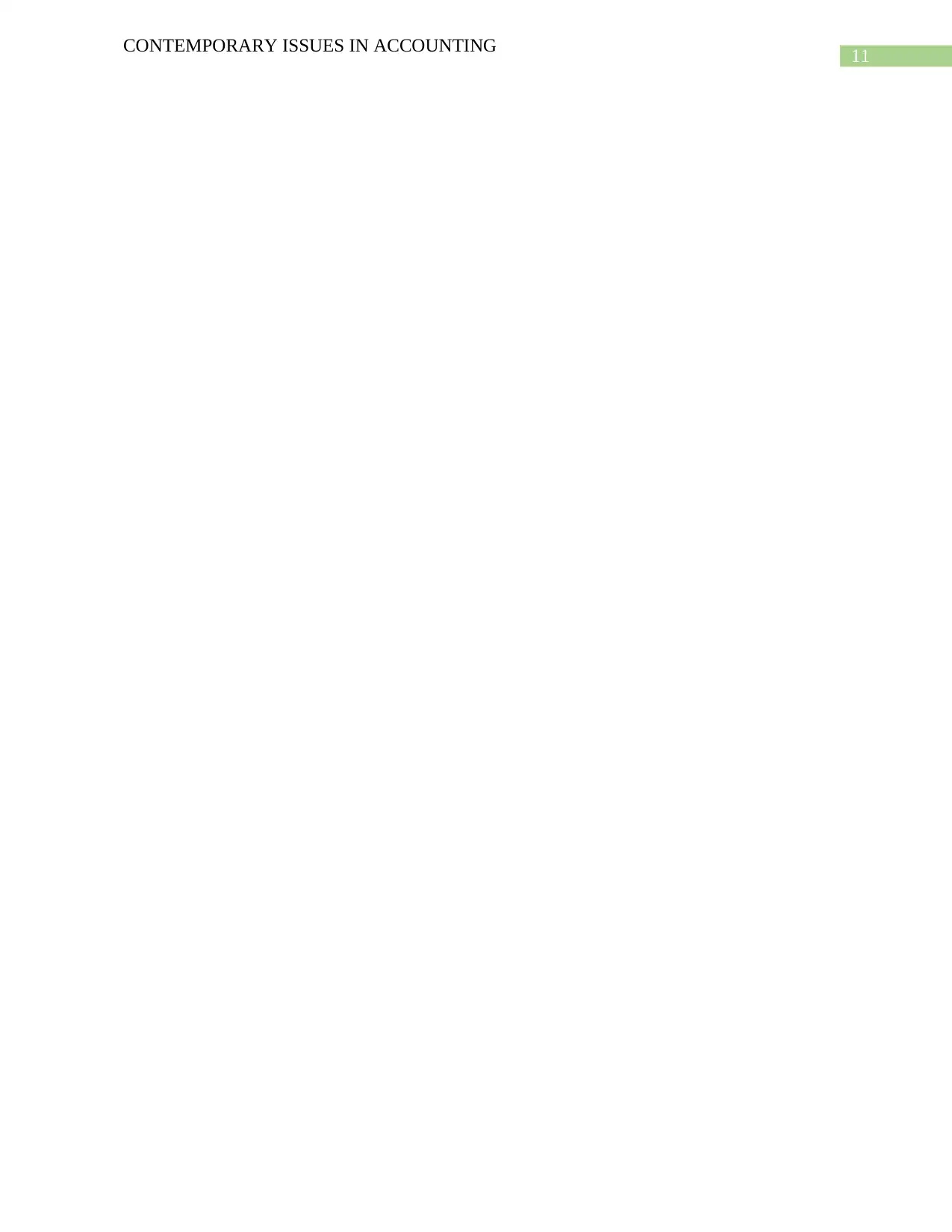
11
CONTEMPORARY ISSUES IN ACCOUNTING
CONTEMPORARY ISSUES IN ACCOUNTING
⊘ This is a preview!⊘
Do you want full access?
Subscribe today to unlock all pages.

Trusted by 1+ million students worldwide
1 out of 12
Related Documents
Your All-in-One AI-Powered Toolkit for Academic Success.
+13062052269
info@desklib.com
Available 24*7 on WhatsApp / Email
![[object Object]](/_next/static/media/star-bottom.7253800d.svg)
Unlock your academic potential
Copyright © 2020–2025 A2Z Services. All Rights Reserved. Developed and managed by ZUCOL.


